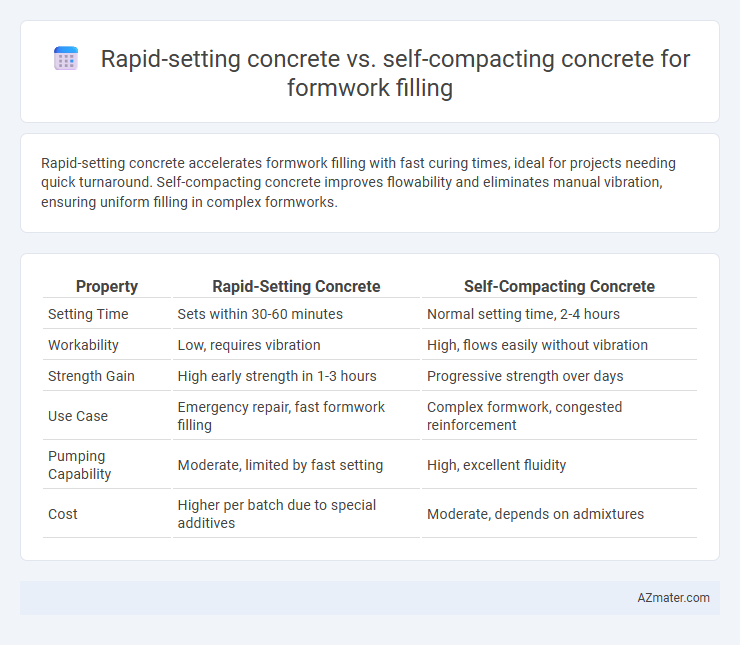Rapid-setting concrete accelerates formwork filling with fast curing times, ideal for projects needing quick turnaround. Self-compacting concrete improves flowability and eliminates manual vibration, ensuring uniform filling in complex formworks.
Table of Comparison
| Property | Rapid-Setting Concrete | Self-Compacting Concrete |
|---|---|---|
| Setting Time | Sets within 30-60 minutes | Normal setting time, 2-4 hours |
| Workability | Low, requires vibration | High, flows easily without vibration |
| Strength Gain | High early strength in 1-3 hours | Progressive strength over days |
| Use Case | Emergency repair, fast formwork filling | Complex formwork, congested reinforcement |
| Pumping Capability | Moderate, limited by fast setting | High, excellent fluidity |
| Cost | Higher per batch due to special additives | Moderate, depends on admixtures |
Introduction to Rapid-setting and Self-compacting Concrete
Rapid-setting concrete features a high-early-strength cementitious matrix that accelerates curing, enabling formwork filling with reduced project downtime and faster load-bearing capacity. Self-compacting concrete incorporates a superplasticizer and viscosity-modifying agents to achieve high flowability, allowing it to fill complex formwork shapes without mechanical vibration or segregation. Both materials offer unique advantages in construction efficiency, with rapid-setting concrete excelling in time-sensitive applications and self-compacting concrete ensuring uniform filling and superior surface finish.
Key Properties of Rapid-setting Concrete
Rapid-setting concrete offers accelerated strength gain, achieving initial set within minutes and full strength in hours, making it ideal for fast-paced formwork filling. Its high early compressive strength and reduced permeability enhance durability and resistance to chemical attacks. The mix design ensures low shrinkage and thermal cracking potential, providing stable formwork support under early load conditions.
Key Properties of Self-compacting Concrete
Self-compacting concrete (SCC) exhibits high flowability and excellent segregation resistance, enabling it to fill complex formwork without mechanical vibration, which is a significant advantage over rapid-setting concrete. SCC's key properties, including viscosity, passing ability, and stability, ensure uniform and dense filling around reinforcement, enhancing structural integrity and surface finish. The enhanced rheological characteristics of SCC reduce labor and equipment costs while providing superior durability and workability in intricate formwork conditions.
Workability and Flow Characteristics
Rapid-setting concrete offers faster strength development ideal for urgent formwork filling but typically requires vibration due to lower flowability and workability. Self-compacting concrete exhibits superior workability and high flow characteristics, enabling it to fill complex formworks without mechanical consolidation. The choice hinges on project timelines and site conditions, balancing rapid strength gain with ease of placement and surface finish quality.
Setting Time and Strength Development
Rapid-setting concrete achieves initial set within 30 minutes to 2 hours, allowing formwork removal as early as 4-6 hours and reaching compressive strengths of 20-30 MPa rapidly for fast-track projects. Self-compacting concrete typically requires 4-6 hours to reach initial set and achieves higher ultimate strengths over 28 days, offering excellent flowability for complex formwork without mechanical vibration. The choice depends on balancing early strength requirements and ease of placement, with rapid-setting concrete excelling in accelerated schedules and self-compacting concrete optimizing quality in dense reinforcement zones.
Formwork Filling Efficiency
Rapid-setting concrete significantly enhances formwork filling efficiency by reducing setting time to as little as 30 minutes, allowing for faster turnover and early removal of formwork. Self-compacting concrete improves efficiency through its high flowability and ability to fill complex formwork without mechanical vibration, ensuring uniform compaction and surface finish. Choosing between the two depends on project priorities: rapid-setting concrete excels in speed, while self-compacting concrete optimizes placement quality and labor reduction.
Surface Finish and Structural Performance
Rapid-setting concrete offers a fast strength gain ideal for tight construction schedules, providing a smooth surface finish with minimal formwork vibration due to its quick setting time. Self-compacting concrete exhibits superior flowability, filling complex formwork shapes effortlessly and achieving a high-quality, uniform surface finish without honeycombing or segregation. Structurally, rapid-setting concrete ensures early load-bearing capacity, while self-compacting concrete enhances long-term durability and homogeneity, optimizing both initial performance and overall structural integrity.
Ease of Placement and Labor Requirements
Rapid-setting concrete offers accelerated strength gain, enabling quicker formwork removal and reduced labor time, but often requires skilled workers to manage its fast curing properties. Self-compacting concrete enhances ease of placement by flowing effortlessly into complex formwork without mechanical vibration, minimizing labor demands and improving surface finish quality. Selecting between these concretes depends on project deadlines and workforce availability, balancing rapid strength development with placement efficiency.
Typical Applications and Best Use Cases
Rapid-setting concrete excels in situations requiring quick turnaround times, such as emergency repairs, road patching, and time-sensitive infrastructure projects where early strength development is critical. Self-compacting concrete is ideal for complex formwork with congested reinforcement, intricate shapes, and areas where manual compaction is difficult or labor-intensive, ensuring uniform filling and superior surface finish. Rapid-setting concrete suits projects prioritizing speed and minimal downtime, while self-compacting concrete is best used in high-quality architectural work and large-scale precast elements needing flawless execution.
Cost Considerations and Sustainability Factors
Rapid-setting concrete reduces labor and formwork removal time, lowering overall project costs but often requires higher initial material expenses and energy-intensive additives. Self-compacting concrete, although typically more expensive due to specialized admixtures, enhances sustainability by minimizing noise pollution, reducing formwork strain, and promoting uniform compaction without mechanical vibration, leading to longer-lasting structures with less maintenance. Balancing cost efficiency with environmental impact favors self-compacting concrete for durable, eco-friendly formwork applications, while rapid-setting concrete suits urgent time-sensitive projects despite higher carbon footprints.

Infographic: Rapid-setting concrete vs Self-compacting concrete for Formwork filling
 azmater.com
azmater.com